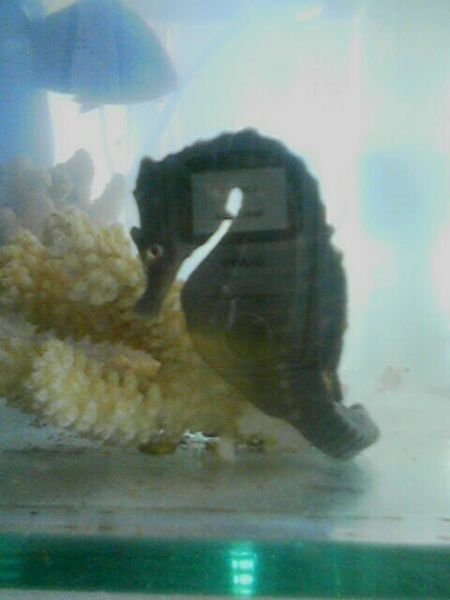 Cryptoheros sajica, formerly known as Archocentrus sajica, hails from Central America and belongs in the same family as the popular Convict Cichlid. I first came across this particular species of fish at an auction in Cleveland, where I picked up a bag for about five bucks. In the bag were 8 fish, each about a half inch in length. At the time I was living in Cleveland, and they all went into a 30 gallon tank. They shared the tank with a 5 inch royal pleco and some neon tetras and rummynoses. I kept the water chemistry stable with a ph of around 7.6 and a general hardness of 6 degrees. The temperature was set at 78 degrees (F). The tank was furnished with live plants, driftwood and clay flower pots. I also added some flat stones, in hopes the new additions would eventually spawn on them.
Cryptoheros sajica, formerly known as Archocentrus sajica, hails from Central America and belongs in the same family as the popular Convict Cichlid. I first came across this particular species of fish at an auction in Cleveland, where I picked up a bag for about five bucks. In the bag were 8 fish, each about a half inch in length. At the time I was living in Cleveland, and they all went into a 30 gallon tank. They shared the tank with a 5 inch royal pleco and some neon tetras and rummynoses. I kept the water chemistry stable with a ph of around 7.6 and a general hardness of 6 degrees. The temperature was set at 78 degrees (F). The tank was furnished with live plants, driftwood and clay flower pots. I also added some flat stones, in hopes the new additions would eventually spawn on them.
They grew pretty quickly. I fed them twice a day, and feeding was very easy. They pretty much ate anything that fell in front of their face. Every other day I performed water changes of about ten percent to keep the chemistry up to par. By the end of the first year they were each about 3 inches long.
Finally, one day I had noticed that two had paired off. They had all the others pinned in corners and fearing for their lives, so the following day I baged up the dominated fish, and traded them in for some baby brine and earthworm flakes before they met an untimely death by the newly territorial and greedy pair. Within days I noticed the couple cleaning one of the flat stones. I also noticed that the female’s breeding tube was visible, a sign that eggs are soon to come. She laid about 100 small. tan-colored eggs the following day. It happened to be my day off, and I was excited that she had laid her first batch of eggs, Little did I know that the pleco decided he had an appetite for caviar. The inexperienced soon-to-be parents tried to keep the intruder away, but the pleco was determined to have his fancy meal. The damage done, I relocated the pleco to my African cichlid tank.
 She had another batch of eggs 3 weeks later. This time they were better prepared, and with no armored, sucker-mouthed egg eaters in their tank, they were on the road to success. These fish are very good parents once they get the hang of it! They guarded their offspring ferociously, even attacking the gravel tube as I tried to clean the substrate. When they were big enough, I moved the fry I could catch to a seperate 20 high. About 50 fry made it to be traded and sold from that batch.
She had another batch of eggs 3 weeks later. This time they were better prepared, and with no armored, sucker-mouthed egg eaters in their tank, they were on the road to success. These fish are very good parents once they get the hang of it! They guarded their offspring ferociously, even attacking the gravel tube as I tried to clean the substrate. When they were big enough, I moved the fry I could catch to a seperate 20 high. About 50 fry made it to be traded and sold from that batch.
I don’t consider sajicas a very vibrant species, though they are attractive in their own way. They remind me a lot of the A. spilurus, with their shimmering blue eyes. Maybe their most striking feature is the blue throat developed by both males and females as they mature. Males attain an adult size of 5 inches and females about 3.5 to 4 inches. With caution they may be kept with community fish, but they are almost always aggressive towards others of their own kind. I would say the minimum tank size for an adult pair would be a 29 gallon. I would highly recommend this species to someone who would like to try something other than a Convict Cichlid. They breed easily and are really fun to watch as they spawn and raise their fry. If you have any questions about them, please let me know in the comments section!
Jose
 Having always kept saltwater tanks, I recently decided to try my hand at a freshwater planted tank. Not having a lot of room to work with, I decided to set up a small, 2.5 gallon tank. With such a small volume of water, I was limited in the fishthat I could keep, but I found a perfect fit for my new tank.
Having always kept saltwater tanks, I recently decided to try my hand at a freshwater planted tank. Not having a lot of room to work with, I decided to set up a small, 2.5 gallon tank. With such a small volume of water, I was limited in the fishthat I could keep, but I found a perfect fit for my new tank. That Fish Blog – Aquarium Advice and Information
That Fish Blog – Aquarium Advice and Information





